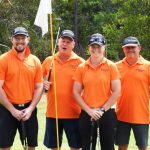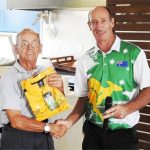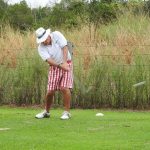Our Greens Staff have installed new inspection pits and made improvements to drainage around tees and greens. As a result we should see better drainage of the 10th and 11th greens, with the former being a concern earlier this year when there was a lot of rain.
We would like to thank Bendigo Bank for sponsoring the acquisition of controlled (slow) release fertiliser which was applied to fairways earlier this month. Very timely.
Due to wet conditions, the course was closed on Tuesday 16th. The following day several walkers played in the Vets competition, completing 18 holes, and reported the course was holding up well considering we got about 400mm of rain over the previous week. The old adage that any aeration is better than no aeration was obvious. There has been extensive use of the Groundhog aerator since we got it and this is resulting in more water moving down the soil profile. Hopefully grass roots will follow and this should result in better and more vigorous growth on fairways, whatever the grass.
Other Activities Completed
- We want to increase the amount of more desirable grass on fairways. The area in front of the 4th tee has been roped off, rotary hoed at a cost of $200 using a local contractor in preparation for the planting of green couch stolons, which will be obtained from Noosa Golf Club soon. Soil preparation will also involve chemical improvement of soil physical properties through gypsum application. Expect to see other areas (bare patches) treated similarly, hopefully in time to take advantage of the generosity of Noosa Golf Club.
- On October 7 and 8, a very successful stump grinding working bee was completed. The job coordinator was Graeme Caffyn who
 put in a fantastic effort in picking up and returning the Grinder from Kennards Hire, as well as being in attendance both days. Volunteers included Graeme and Rosemary Caffyn, Dale Scanlon, Doug Pearce, Joe Daniels, Gordon Green, Derek Wood, Dale Rickard and Dave Lyons. Approximately 140 tree stumps (potential trip hazards and eyesores) no longer exist. The photo below shows the Monday morning shift – left to right Dale Scanlon, Derek Wood using the grinder, Doug Pearce and Dale Rickard.
put in a fantastic effort in picking up and returning the Grinder from Kennards Hire, as well as being in attendance both days. Volunteers included Graeme and Rosemary Caffyn, Dale Scanlon, Doug Pearce, Joe Daniels, Gordon Green, Derek Wood, Dale Rickard and Dave Lyons. Approximately 140 tree stumps (potential trip hazards and eyesores) no longer exist. The photo below shows the Monday morning shift – left to right Dale Scanlon, Derek Wood using the grinder, Doug Pearce and Dale Rickard.
Some Very Good and Not So Good News
- Bad news first. We are seeing a lot of couch intrusion on our Tiffdwarf greens nursery and it may be we will have to spray the whole lot out and start again. This is very disappointing. For this to happen so quickly must be due to the quality of the stolons we sourced from another golf club. Stolons of couch from surrounds of greens appear to have been included in with stolons from their Tiffdwarf greens. Getting a good quality source of Tiffdwarf stolons could be challenging. Tiffgreen (328) which is the grass currently on our greens is still one of two good quality industry standards along with Tiffdwarf, and we may choose to collect stolons from our good greens on course for the Greens nursery.
- We recently met with two officers from the Department of Natural Resources to discuss our water licence and our desire to use more water on the course. DNR were very helpful. They advised that our current water licence needs to be changed to cover how we currently use water. They will take us through this as well as an increase in our potential water use. We can take steps to increase water storage now and with more membership and revenue down the track, there is potential to increase storage further e.g. a dam on 2nd/16th might be of interest.
- Another good outcome by calling in local authorities. It is very likely that we will be involved in a very significant project with Noosa Landcare (who receive Commonwealth funding for projects that benefit the community). After heavy rain we see a lot of turbidity in the creek from run-off and erosion of creek beds on course. The initial meeting with Landcare had them talking about the planting of a large number of native aquatic plants on our creek beds which will serve as filters to trap sediment and nutrients that may enter waterways, thus improving our environmental footprint. Plants would be supplied and planted by Landcare. We need to match that commitment with in-kind contribution from the Club (working bees) and the Community (sponsorship of rocks, soil, school projects being examples).





